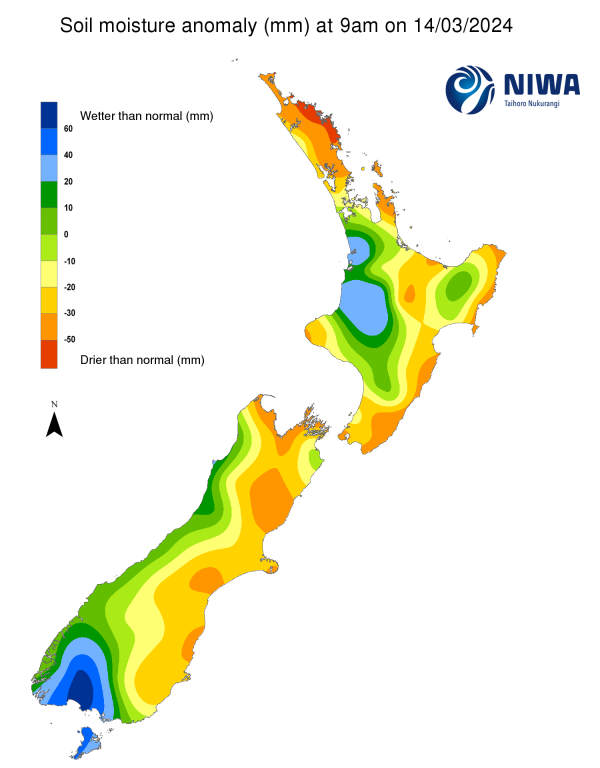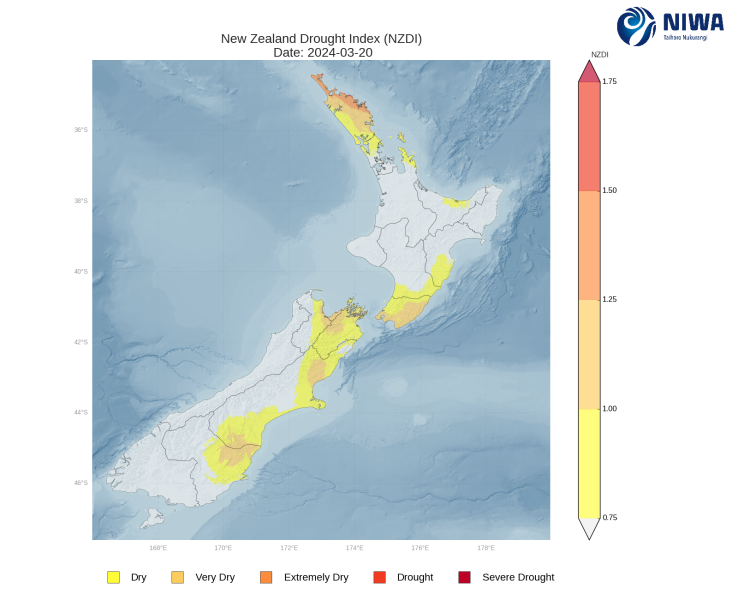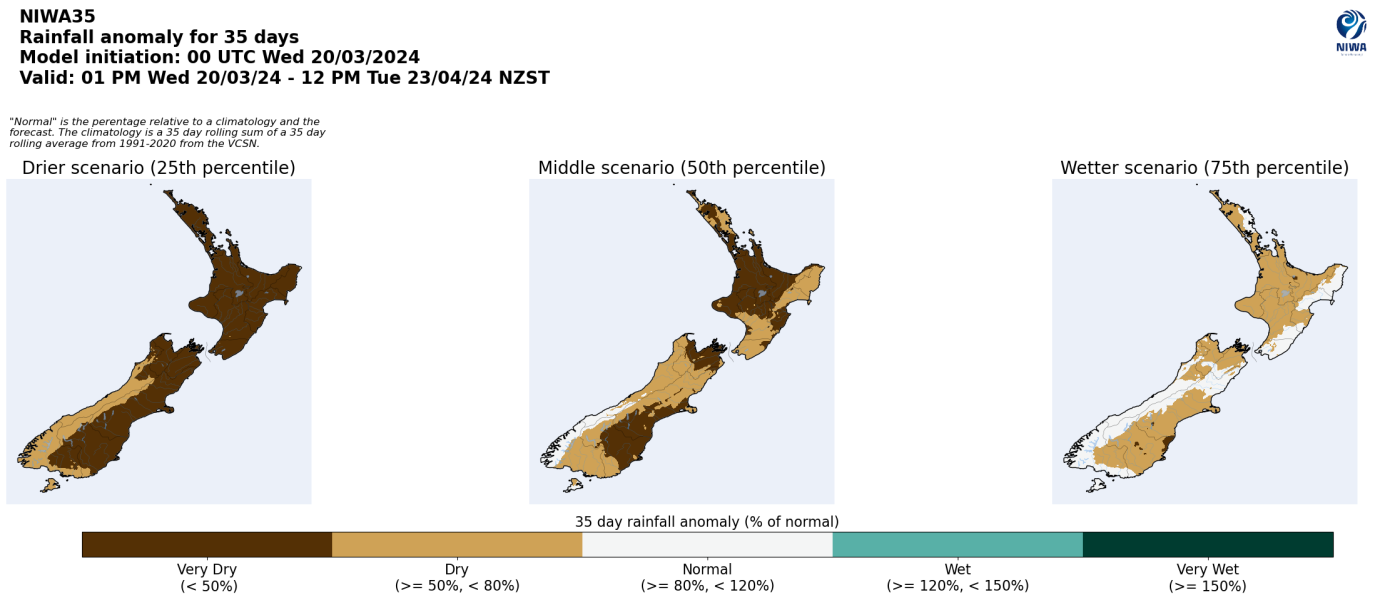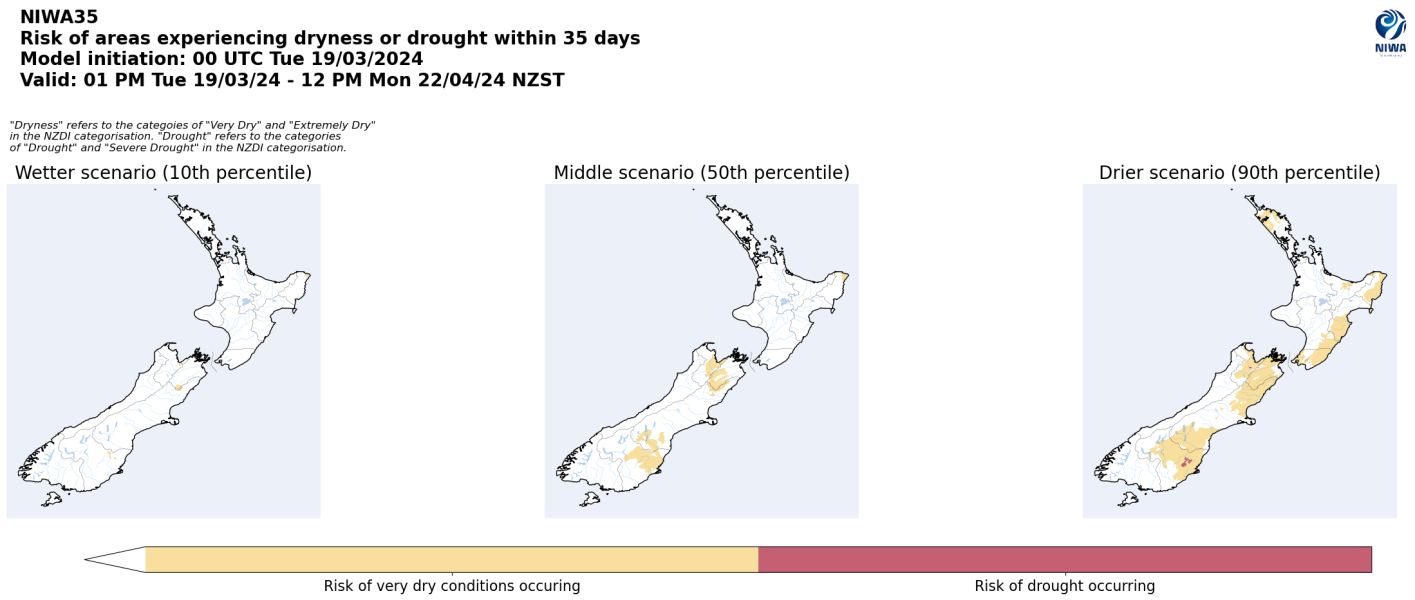A weekly update describing soil moisture patterns across the country to show where dry to extremely dry conditions are occurring or imminent. Regions experiencing significant soil moisture deficits are deemed “hotspots”. Persistent hotspot regions have the potential to develop into drought.
Recent rainfall and current soil moisture conditions:
North Island:
- Parts of the central North Island including Waikato, Bay of Plenty, and Hawke’s Bay saw moderate rainfall amounts in the past week of 20-40 mm.
- However, upper and lower parts of the North Island generally received meagre rainfall amounts of 10 mm or less.
- Overall the soil moisture situation across the North Island did not change significantly in the past week, but some small additional decreases were observed.
- The driest soils across the North Island, when compared to normal for this time of the year, are found in eastern Northland and the northern Coromandel Peninsula, while the wettest soils for this time of the year are found in western and southern Waikato.
- Hotspots are currently located across most of Northland, northern Auckland, southern Hawke’s Bay to Wairarapa, and Kāpiti Coast.
- As of 20 March, the New Zealand Drought Index (NZDI) map below shows that abnormally dry conditions are currently found in Northland, Auckland, northern Coromandel Peninsula, eastern Bay of Plenty, southern Hawke’s Bay, southern Manawatū-Whanganui and Wellington. Very dry to extremely dry conditions are located in much of Northland and Wellington. In addition, parts of eastern Northland are on the precipice of meteorological drought.
South Island:
- Much of the South Island saw rainfall totals of 15-25 mm in the past week, with pockets of the lower South Island receiving 30-40 mm.
- Rainfall was again meagre in Tasman, Nelson, and much of Marlborough where weekly totals were less than 10 mm.
- This resulted in small soil moisture decreases across much of the South Island, although central and southern Canterbury and eastern Otago saw minor soil moisture increases.
- The driest soils across the South Island, when compared to normal for this time of the year, are found in northern Tasman, while the wettest soils for this time of the year are found in western Southland.
- Hotspots are currently located across eastern Tasman, Nelson, parts of Marlborough, large portions of Canterbury, and small parts of eastern Otago, although the remainder of Canterbury and Otago are near hotspot status.
- As of 20 March, the New Zealand Drought Index (NZDI) map below shows that abnormally dry conditions are currently found in Wellington, eastern Tasman, Nelson, several parts of Canterbury, and eastern Otago. Very dry to extremely dry conditions are located in Nelson, parts of Marlborough, parts of northern and far southern Canterbury, and northern Otago.
Key Messages for the Top of the South Island:
- From October 2023 through February 2024, Blenheim recorded just 88 mm of rain – the lowest rainfall over that period since at least 1941.
- Many parts of the region experienced six or seven consecutive months with below normal rainfall, depending on the location.
- This severe rainfall deficit culminated in a precipitation drought for parts of Marlborough, Nelson, and Tasman.
- Read the government’s declaration of a medium-scale adverse event here.
Pictured above: Soil Moisture Anomaly Maps, relative to this time of year. The maps show soil moisture anomalies over the past two weeks.
As of 20 March, the New Zealand Drought Index (NZDI) map below shows that abnormally dry conditions are currently found in Northland, Auckland, northern Coromandel Peninsula, eastern Bay of Plenty, southern Hawke’s Bay, southern Manawatū-Whanganui, Wellington, eastern Tasman, Nelson, several parts of Canterbury, and eastern Otago. Very dry to extremely dry conditions are located in much of Northland, Wellington, Nelson, parts of Marlborough, parts of northern and far southern Canterbury, and northern Otago. In addition, parts of eastern Northland are on the precipice of meteorological drought. Please note: some hotspots in the text above may not correspond with the NZDI map. This difference exists because the NZDI uses additional dryness indices, including one which integrates the rainfall deficit over the past 60 days. Changes are therefore slower to appear in the NZDI compared to soil moisture anomaly maps that are instantaneously updated.
The week ahead:
North Island:
- An area of light to moderate rain will move across the upper half of the North Island on Saturday (23 March), followed by scattered showers on Sunday afternoon (24 March).
- Monday through Wednesday (25-27 March) will feature isolated to scattered showers in western regions, while other areas generally remain dry.
- There will be a better chance for more numerous showers or even areas of steadier rain towards the end of next week.
- Weekly rainfall totals of 30-50 mm will be possible in the western and central North Island, but eastern Northland and parts of the east coast may again see light rainfall totals below 15 mm.
- Due to the expected rainfall in the next week, moderate soil moisture increases may occur in the western North Island, but additional decreases may occur in the Far North and parts of the east coast.
- Current hotspots in the Far North and lower east coast will have the best chance to strengthen at least slightly in the next week.
South Island:
- A few showers will affect the lower South Island on Saturday afternoon (23 March).
- Monday through Thursday (25-28 March) will likely be quite unsettled, with several rounds of moderate to heavy rain affecting the West Coast and lower South Island. However, the upper South Island and coastal Canterbury may miss out on the bulk of this rainfall.
- Weekly rainfall totals of 100-200 mm will affect the central and lower West Coast, with 30-70 mm possible in parts of Otago and Southland.
- However, coastal Canterbury and the upper South Island may only receive 15-20 mm or less.
- Due to the expected rainfall in the next week, additional soil moisture decreases could occur in the upper South Island, while notable increases will be possible in the lower South Island and parts of the West Coast.
- The current hotspots in the upper South Island could strengthen at least slightly in the next week, with those in southern Canterbury and Otago potentially easing to an extent.
Long-term outlook (through late April):
- The drier (25th percentile) and middle (50th percentile) rainfall scenarios both show drier or much drier than normal conditions across nearly all of New Zealand , leading to higher confidence for that outcome.
- Even in the wetter (75th percentile) scenario, below normal rainfall remains forecast in many regions across both islands.
- Very dry soil conditions could affect the eastern South Island in all three rainfall scenarios, along with parts of the upper and eastern North Island in the drier scenario.
Pictured above: 35-day forecast rainfall anomaly scenarios (Top), and 35-day forecast dryness and drought scenarios (Bottom). These maps are updated daily at https://niwa.co.nz/climate/seasonal-climate-outlook
Background:
Hotspot Watch: a weekly advisory service for New Zealand media. It provides soil moisture and precipitation measurements around the country to help assess whether extremely dry conditions are imminent.
Soil moisture deficit: the amount of water needed to bring the soil moisture content back to field capacity, which is the maximum amount of water the soil can hold.
Soil moisture anomaly: the difference between the historical normal soil moisture deficit (or surplus) for a given time of year and actual soil moisture deficits.
Definitions: “Extremely” and “severely” dry soils are based on a combination of the current soil moisture status and the difference from normal soil moisture (see soil moisture maps at https://www.niwa.co.nz/climate/nz-drought-monitor/droughtindicatormaps)
Hotspot: A hotspot is declared if soils are "severely drier than normal" which occurs when Soil Moisture Deficit (SMD) is less than -110 mm AND the Soil Moisture Anomaly is less than -20 mm.


![Soil moisture anomaly map (mm) at 9am on 14 March 2024. [NIWA]](/sites/default/files/styles/portrait/public/2024-03/smdanom_20240321.png?itok=RW_oT-jJ)



